

Move your mouse over the picture to see the names of the various craters.
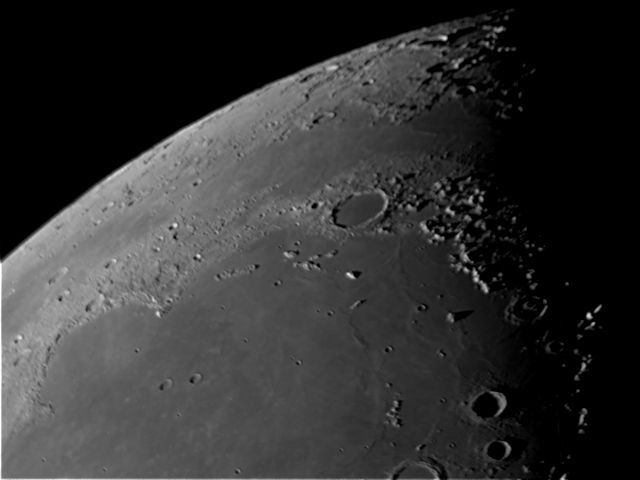
This is a wide-angled view of the north-west quadrant of the Moon taken at third quarter The major features are the Mare Imbrium in the south, bordered in the west by the Jura mountains and in the east by the Alps, and the crater Plato almost in the centre of the picture.
The libration was almost as unfavourable as it gets for this part of the Moon at -5° 38' in latitude and +7° 49' in longitude.
In a wide-angle picture of this part of the Moon, the scale varies across the picture, but the scale markers represent approximately 100 Km north and west and apply at Plato.
The picture was taken with an Atik camera attached to my LX200 on 14th October 2006, when the Moon was 22.3 days old.
Date and Time: 14th October 2006 03:23 UT
Lunar Phase: 268.7°
Colongitude: 173.9°
Libration: Latitude -5° 37', Longitude 7° 53'
Camera: Atik 1-HS
Telescope: LX200 with 0.33 focal reducer
Capture: K3CCDTools. 50% gamma, 1/100", 25% gain, 611 frames
Processing: Registax. 6 alignment points, 466 frames stacked. Gaussian wavelets 1 = 20, 2 = 10, gamma 1.3, brightness -14
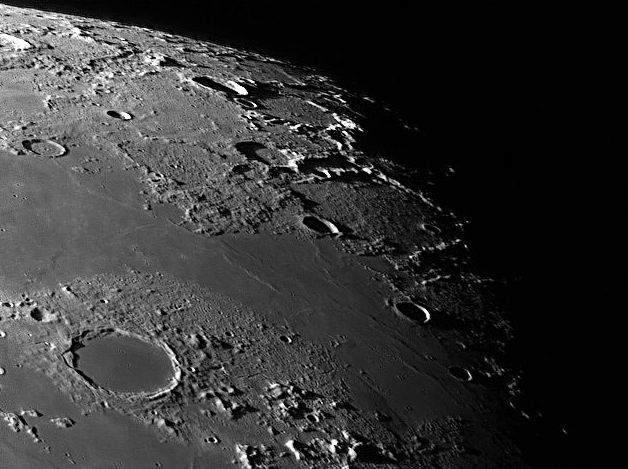
This is the northern part of the picture above, taken a day and a half earlier. However, the libration was rather less unfavourable than in the picture above at -4° 38' in latitude and -6° 50' in longitude, so the Moon has swung 14° to the East compared to the picture above. However the picture was taken 1½ days earlier in the lunar cycle, so the terminator is close to the same position.
The picture was taken with a DMK camera attached to my LX200 on 31st August 2010, when the Moon was 20.7 days old.
Date and Time: 31 August 2010 04:42 UT
Lunar Phase: 288.3°
Colongitude: 168.4°
Libration: Latitude -4° 38', Longitude -6° 50'
Camera: DMK 21AF04
Telescope: LX200 at prime focus
Capture: ICCapture. 1/108", gain 716, 3500 frames
Processing: Registax. 107 frames stacked. Wavelet 1 = 10, 2 = 5, gamma 1.2
Focus Magic 1,100
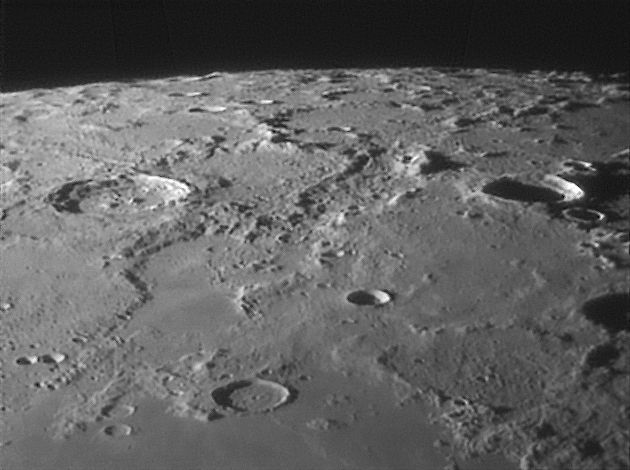
This area is just to the west of the one above.
The picture was taken with a DMK camera attached to my LX200 on 9th October 2020 with an IR-pass filter, when the Moon was 21.4 days old.
Date and Time: 9 October 2020 05:34 UT
Lunar Phase: 279.4°
Colongitude: 177.6°
Libration: Latitude -1° 14', Longitude -7° 1'
Camera: DMK 21AF04
Telescope: LX200 at prime focus with IR-pass filter
Capture: ICCapture. 1/91", gain 1023, 1794 frames
Processing: Registax6. 32 alignment points, 400 frames stacked per alignment point. Wavelet 1-2 = 10, gamma 1.3
Focus Magic 4
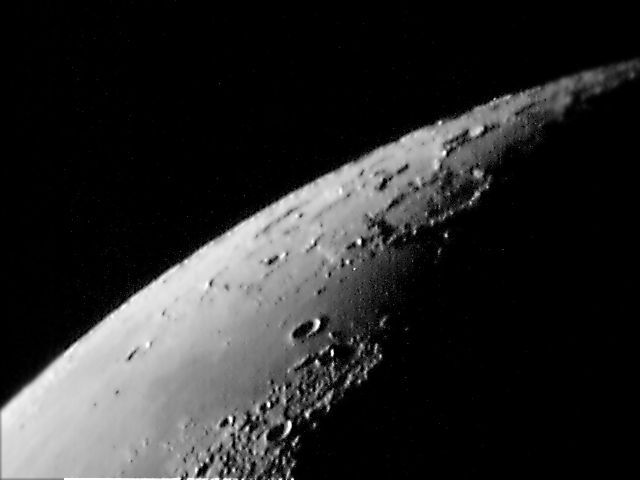
This is the north-western limb of the Moon. These areas are difficult to image well. Not only are the features foreshortened by perspective, so are the shadows and the lighting is never right. At full Moon the light is coming from behind
the camera, so we don't see the shadows that are there. Here we see the area at sunset, but the light is coming towards the camera and reflections make the surface bright.
The picture was taken with a ToUcam attached to my ETX125 on 24th August 2003, when the Moon was 24.9 days old.
Date and Time: 23rd August 2003 03:06 UT
Lunar Phase: 235.9°
Colongitude: 218.5°
Libration: Latitude -3° 34', Longitude -3° 47'
Camera: ToUcam 740K
Telescope: ETX125 at prime focus
Capture: K3CCDTools. High gamma, 1/25", 40% gain, 187 frames
Processing: Registax. 30 frames stacked. Wavelet 1-3 = 5
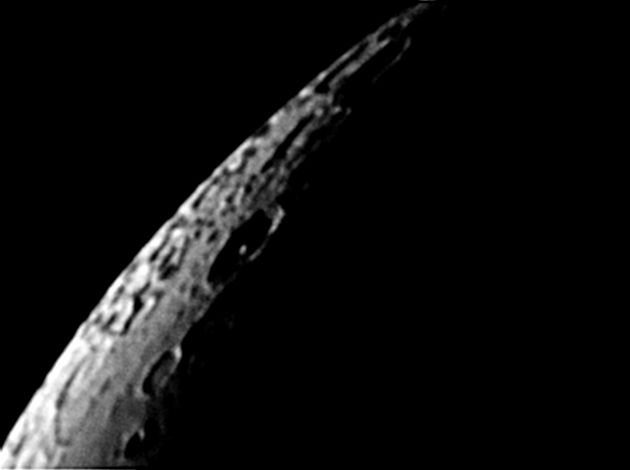
I don't think I would have published this picture if it had not been for the exceptionally favourable libration (6° 15' in latitude and -3° 16' in longitude) which has really tipped the libration zone into view. Conditions were very difficult; the picture was taken only 20 minutes before sunrise with the Moon at an altitude of 14° on lunar day 26.3. As pointed out by Jim Mosher and Charles Wood in the LPOD for 28th May 2007, interpreting pictures of a thin crescent Moon is difficult because mountains tend to look dark, and flat areas tend to look bright. This is because the light is coming towards the camera, so we see the un-illuminated side of the mountains, but the flat areas tend to reflect the light into the camera. I have done my best to identify the craters correctly by superimposing an image from the VMA but even so it is difficult to be sure.
The effect of libration may be seen by comparing this image with this one in which the libration was almost exactly the opposite of that here.
The picture was taken with a ToUcam attached to my ETX125 on 17th December 2006, when the Moon was 26.3 days old.
Date and Time: 17th December 2006 07:52 UT
Lunar Phase: 218.4°
Colongitude: 235.3°
Libration: Latitude 6° 15', Longitude -3° 16'
Camera: Atik 1-HS
Telescope: ETX125 at prime focus with IR-pass filter
Capture: K3CCDTools. High gamma, 1/25", 67% gain, 507 frames
Processing: Registax. 333 frames stacked. Wavelet 1-3 = 5, sigmoid gamma, histogram 50-220, gaussian wavelets 1 @0.3 = 0, 2 @0.1 = 20 Home Back to NW quadrant